
Baldur's Gate 3 Paladin Class Guide - The best Oaths, becoming an Oathbreaker, and play suggestions
Who doesn't want to be a knight in shining armor that foils evildoers and saves the innocent? People who don't choose to be a Paladin in Baldur's Gate 3, that's who. The Paladin fulfills the classical archetype of a roaming defender of the good and just, using the conviction of their sacred oath to channel divine power to just ends - or to punish the wicked. Keep reading for our full class guide to the Baldur's Gate 3 Paladin, and learn more about how to play and build them. For other classes and aspects of the game, see our full slate of available Baldur's Gate 3 guides.
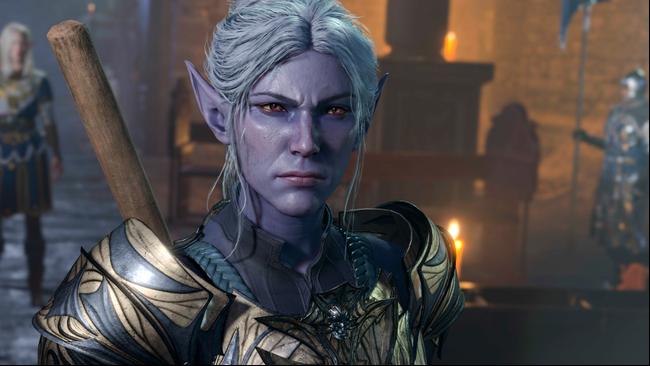
Before You Begin
Note that none of these points are set in stone. Build your character the way you choose, and see these notes more as suggestions than rules. For more tips, check out our Baldur's Gate 3 Character Creation guide.
This guide will also assume that you are building a custom character. Origin Characters have unique interactions and roleplaying options available thanks to their preset nature. Though there are no Paladin Origin Characters by default, you may choose The Dark Urge and build them as a Paladin. Minthara is a recruitable Paladin party member.
Additionally, this guide presumes you are building a single-class character. Multiclassing into different classes as you level up is an option to gain new and useful abilities, but there’s also value in specialization. We’ll have a few multiclass suggestions for you at the end of the guide.
The Paladin Playstyle
By default, the Paladin is best played as a sort of hybrid of a Fighter and a Cleric. Paladins will mainly live their lives on the front lines of battle, defending their allies and bringing justice to their enemies. They'll use their Divine Smite ability to bring pain to everything from mundane beasts to extraplanar fiends. They can also cast a few spells, mostly for helping or healing allies, but with a few options to really boost their damage output. Paladins also have high Charisma, and can serve as highly capable leaders of the party and "faces" for taking on social tasks. Just about the only thing they can't do is pick a lock, fight really well at range, or use certain categories of skill.
Paladin playstyles can also differ greatly based on your selection of sacred oath, with each of the four subclasses in Baldur's Gate 3 conforming to a different combat approach. The fourth Paladin subclass isn't actually available at creation, and it's something you unlock through your actions.
Paladins are slightly less mobile than Fighters, Barbarians, or Monks, since they don't get too many features that allow them to close distance quickly. Consider compensating by calling on support from party members, or choosing races, feats, or magical equipment that can boost a character's movement speed.
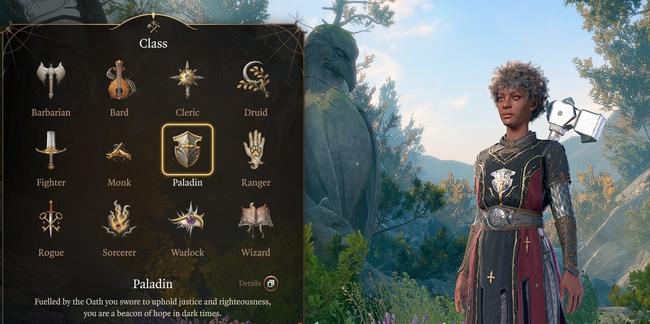
Paladin Class Features
- Key Abilities: Strength and Charisma
- Paladins are classical martial characters, using Strength for combat and Charisma to power their spellcasting.
- A high Constitution is also helpful to improve a Paladin's HP as a close-range combatant.
- Gear Proficiency: Light, Medium, and Heavy Armor, Shields, Simple and Martial Weapons.
- Paladins can use any gear in the game that's not specific to a certain class.
- Skill Proficiency: At creation, Paladins can gain Proficiency in two Skills from the following list. Paladins can make good use of the Athletics and Intimidation skills thanks to their high bonuses, but Persuasion, Religion, and Insight also benefit from their abilities.
- Athletics
- Intimidation
- Insight
- Medicine
- Religion
- Persuasion
- Divine Smite: One of the Paladin's most popular powers, the Divine Smite is the bread-and-butter of the Paladin's melee damage. Divine Smites add radiant damage to a Paladin's melee attacks. The only regulating factor for Divine Smite's power is that using it expends a spell slot, with higher-level slots doing more damage. Thankfully, the slot isn't "wasted" if the smite misses.
- Lay on Hands: Paladins can heal themselves or their allies at close range using the Lay on Hands ability. It's a good healing ability that improves with level gains.
- Channel Oath: Paladins can tap into the power of their sacred oath to unleash powerful benefits once per rest. Channel Oath abilities can change dramatically based on your choice of subclass. Check our subclass options info below for more about these abilities.
- Auras: Paladins gain auras that bestow magical effects on allies around them, and these auras improve and stack as they gain levels. Starting with bonuses to saving throws, a Paladin's mere presence can protect themselves and allies from fear and charm. Oathbreakers even get an aura that strengthens the undead and fiends they can summon.
- Paladin Spellcasting: Paladins cast spells like Clerics, but use Charisma as their main stat. Paladin spells generally favor buffs and healing, but there are a few direct damage or elemental infusion spells available.
Paladin Gear Recommendations
- Paladins should lean into the stereotype of the knight as a heavily armored melee combatant, wearing heavy armor and wielding a shield and one-hander or a two-handed great weapon. This is because focusing on heavy armor and pumping Strength and Charisma reduces the Ability Score burden Paladins face when leveling up compared with trying to pump Dexterity to gain an armor class bonus.
- Paladins also don't gain any particular benefits emphasizing ranged combat, like the Fighter's Archery Fighting style or the many combat cantrips available to spellcasters. A simple crossbow, bow, or a stack of throwing weapons will tide a Paladin over when fights are out of arm's reach when combined with the class' small but meaningful number of direct damage spells
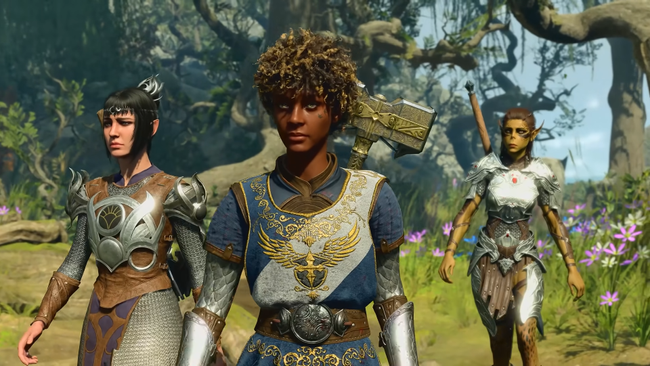
Paladin Subclasses
Paladins choose their "subclass" at creation by selecting a sacred Oath. The three initial Oaths are the Oath of Devotion, Oath of the Ancients, and Oath of Vengeance. This Oath powers and guides all of the Paladin's actions, through its tenets. Tenets are essentially rules that determine a Paladin's behavior in quests and towards NPCs. Acting against those rules can result in a violation of the Paladin's Oath, stripping them of the powers they gain by adhering to it. Paladins who violate their Oath can have it restored, but those who choose to stay tainted by their actions can unlock a special fourth subclass: The Oathbreaker. Choosing to remain an Oathbreaker frees a Paladin from the obligations of their Oath, but changes their powers and progression significantly.
Putting aside narrative elements, each subclass emphasizes different approaches to combat for the Paladin. Devotion Paladins blend defense and buffs with healing. Ancients Paladins focus more on control abilities and Druid-like powers. Vengeance Paladins trade some party support buffs and healing for powers that target single enemies and make them vulnerable to execution. Oathbreakers can inflict fear and use hateful powers to manipulate undead.
Oath of Devotion
The classical "Lawful Good" Paladin, the Oath of Devotion guides a Paladin that wants to be a holy knight that fights for good in shining armor. Paladins following this Oath need to act heroically, help those in need, show mercy, and obey the law (provided the law is just). Their powers tend towards protective magic or magic that defends the Paladin and their allies from evil. They're also particularly effective against undead and evil outsiders like fiends.
Tenets of the Oath of Devotion
- Courage. Stride dauntlessly into action.
- Compassion. Show clemency when prudent, and lend your arm to those in need.
- Duty. Tend your responsibilities, obey just laws, and support those entrusted to your care.
Subclass Features
- Holy Rebuke: The Holy Rebuke hits an enemy that dares to attack you with Radiant damage. It's a good technique, considering Paladins are expected to be in melee most times.
- Sacred Weapon: A simple but effective weapon enhancement makes your melee attacks more likely to hit, as well as lighting up dark areas (useful if you lack Darkvision).
- Turn the Unholy: The classic "Turn" spell common to Paladins and Clerics, Turn the Unholy sets undead and fiends to flight.
- Oath Spells: Devotion spells commonly replicate beneficial cleric spells. These listed below are exclusive to the Oath, though there are other spells Paladins can cast.
- Protection from Evil and Good, Sanctuary, Lesser Restoration, Beacon of Hope, Remove Curse
- Aura of Devotion: Charm can be an annoying debuff to deal with, but the Aura of Devotion protects the whole party from such spells.
Oath of the Ancients
A Paladin following the Oath of the Ancients is still expected to play nice, but is more "Druid-flavored". Ancients Paladins gain the ability to use a powerful area heal, and have Oath spells that lean into area control and feats usually associated with Rangers and Druids, like speaking with animals. They gain a powerful defensive aura that outright nerfs incoming enemy spells on the party. If you've ever felt like just shrugging off an enemy Fireball spell, the Oath of the Ancients gives you a way to do that.
Tenets of the Oath of the Ancients
- Kindle the Light. Through your acts of mercy, kindness, and forgiveness, kindle the light of hope in the world, beating back despair.
- Shelter the Light. Where there is good, beauty, love, and laughter in the world, stand against the wickedness that would swallow it. Where life flourishes, stand against the forces that would render it barren.
- Preserve Your Own Light. Delight in song and laughter, in beauty and art. If you allow the light to die in your own heart, you can't preserve it in the world.
Subclass Features
- Healing Radiance: A strong area heal that can come in handy in a party fight.
- Nature's Wrath: A short-range restraint spell that also debuffs an enemy.
- Turn the Faithless: The classic "Turn" spell common to Paladins and Clerics, Turn the Unholy sets undead and fiends to flight.
- Oath Spells: Ancients spells commonly replicate Druid spells. These listed below are exclusive to the Oath, though there are other spells Paladins can cast.
- Speak With Animals, Misty Step, Ensnaring Strike, Moonbeam, Protection from Energy, Plant Growth.
- Aura of Warding: A very powerful aura at high levels, the Aura of Warding ensures that Paladins and the people close to them take just half damage from spells. It stacks with other magical protections the party can put up, greatly reducing the threat of enemy AOE techniques.
Oath of Vengeance
The Oath of Vengeance is for Paladins that think the other Oaths are too soft on evildoers, and for players that believe there isn't justice without someone getting punished. Accordingly, a Vengeance Paladin's toolkit discards the extra "fluff" of team support powers and healing actions in favor of techniques that make it easier to chase down and wipe out baddies.
If Paladins sworn to other Oaths are ideal tanks, Vengeance Paladins are born strikers, diving deep into battle and taking out tough foes directly. For a Vengeance Paladin, the best way to safeguard their allies is to eliminate threats to them, immediately and without mercy.
Tenets of the Oath of Vengeance
- Fight the Greater Evil. Exerting your wisdom, identify the higher morality in any given instance, and fight for it.
- No Mercy for the Wicked. Chasten those who dole out their villainy by wiping their blight from the world forever.
Subclass Features
- Inquisitor's Might: A minor weapon buff for yourself or an ally that adds some Radiant damage, but is more valuable for its ability to daze targets.
- Abjure Enemy: This is the Vengeance Paladin's "Turn" ability. Instead of an AOE fear effect that sends undead and outsiders fleeing, it morphs into a single-target fear debuff that stops an enemy in their track, with Fiends and Undead disadvantaged on the save.
- Vow of Enmity: A basic but effective buff that gives you Advantage on attack rolls against one enemy for 10 turns. Great for singling out the strongest target on the field.
- Oath Spells: Vengeance Oath Spells are tailored for using the Paladin in a striker role, favoring single-target debuffs and the mobility-boosting Misty Step.
- Bane, Hunter's Mark, Hold Person, Misty Step, Haste, Protection from Energy
- Relentless Avenger: Instead of an additional Aura effect, Vengeance Paladins gain Relentless Avenger, a passive buff that increases the Paladin's movement speed after hitting an enemy with an Opportunity Attack. This allows them to chase down any enemy that attempts to move away from their reach.
Oathbreaker
The Oathbreaker Paladin is a subclass that isn't accessed at character creation but as the result of narrative choices made during the game. Essentially, breaking the tenets of your Paladin Oath causes you to become an Oathbreaker. You can choose to restore your Oath for a large sum of money, but opting to remain an Oathbreaker gives you a new set of powers and progression, replacing your initial subclass retroactively. Oathbreakers are similar to the "antipaladin" or "Blackguard" paladin class from previous editions of Dungeons & Dragons.
Oathbreaker powers can be quite strong and essentially allow a Paladin to benefit from "pets" in the form of undead, as well as inflicting fear and outright magically wounding enemies.
Subclass Features
- Spiteful Suffering: A damage-over-time action that causes a target to take Necrotic damage, as well as granting Advantage on attack rolls against it.
- Control Undead: An illustration of the Oathbreaker as essentially a backwards Paladin, this power mind-controls an undead creature, turning it into a familiar until it dies or you perform a long rest.
- Dreadful Aspect: The Oathbreaker's "turn" action loses the special effectiveness other subclasses have against outsiders and undead, but still sends foes fleeing.
- Oath Spells: Oathbreaker spells focus on wounding, crowd control, and summoning undead minions.
- Hellish Rebuke, Crown of Madness, Darkness, Inflict Wounds, Bestow Curse, Animate Dead.
- Aura of Hate: The Oathbreaker's aura synergizes well with the subclasses' summoning abilities, granting extra melee damage to the oathbreaker and any undead and fiends in its radius.
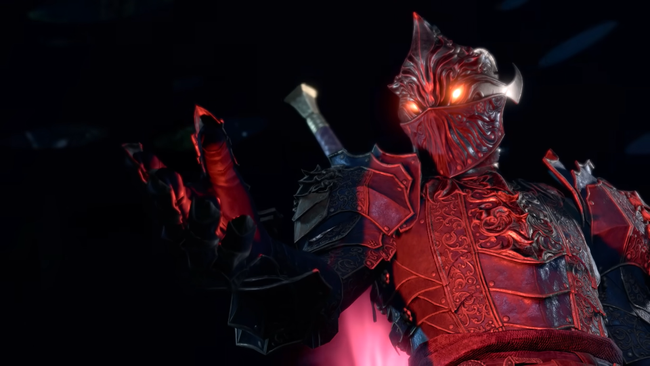
Paladin Level Progression
These are the class features you’ll get as you level up as a Paladin. The maximum level cap in Baldur’s Gate 3 at launch is Level 12. Use this to see what you’ll get at each level and plan accordingly, in case you wish to multiclass.
This guide will also highlight class features you gain based on your subclass choice. For more detailed info about the subclasses, see the sections above. Features gained by a Subclass are labeled with the Subclass name.
Note: Unlabeled benefits are “standard” class features and common to all subclasses.
Level 1
- HP: 10 HP + Constitution Modifier, gaining minimum of 6 HP + Con modifier per level.
- Channel Oath
- Lay On Hands
- Divine Sense: Advantage on Attack Rolls against fiends, celestials, and undead
- Paladin Oath
- Devotion: Holy Rebuke
- Ancients: Healing Radiance
- Vengeance: Inquisitor's Might
- Oathbreaker: Spiteful Suffering
Level 2
- Divine Smite: Expend spell slots to do radiant damage on melee weapon attacks.
- Paladin Spellcasting
- 2 Level 1 spell slots
- Fighting Style: Choose 1 from Defense, Dueling, Great Weapon Fighting, Protection.
Level 3
- Divine Health: Immune to disease.
- Channel Oath Actions: Subclass-based actions
- Devotion: Sacred Weapon, Turn the Unholy
- Ancients: Nature's Wrath, Turn the Faithless
- Vengeance: Abjure Enemy, Vow of Enmity
- Oathbreaker: Control Undead, Dreadful Aspect
- Paladin Spells
- +1 Level 1 spell slots (3 total)
- Oath Spells: Subclass-based spells
- Devotion: Protection from Evil and Good, Sanctuary
- Ancients: Speak With Animals, Ensnaring Strike
- Vengeance: Bane, Hunter's Mark
- Oathbreaker: Hellish Rebuke, Inflict Wounds
Level 4
- Lay on Hands: +1 charges
- Feat Selection: Can pick a Feat from All Classes Feat list. While any class at level 4 can pick many of the Feats, not all will be relevant to the class. You can also choose an ability improvement to boost a bonus or eliminate a penalty. Check out our full Feats guide for more advice on Paladin-appropriate Feats.
- Recommended Paladin Feats:
- Ability Improvement
- Athlete
- Charger
- Durable
- Great Weapon Master
- Heavy Armor Master
- Lucky
- Mobile
- Polearm Master
- Skilled
- Savage Attacker
- Shield Master
- Sentinel
- Tavern Brawler
- Tough
- Recommended Paladin Feats:
Level 5
- Extra Attack: Can make an additional free attack when making an unarmed or weapon attack.
- Paladin Spells
- +1 Level 1 spell slots (4 total)
- 2 Level 2 spell slots
- Oath Spells: Subclass-based spells
- Devotion: Lesser Restoration, Silence
- Ancients: Misty Step, Moonbeam
- Vengeance: Hold Person, Misty Step
- Oathbreaker: Crown of Madness, Darkness
Level 6
- Aura of Protection: Bonus to saves for you and nearby allies.
Level 7
- Paladin Spells
- +1 Level 2 spell slots (3 total)
- Devotion: Aura of Devotion: Immunity to charm for you and nearby allies
- Ancients: Aura of Warding: You and nearby allies take half damage from spells
- Vengeance: Relentless Avenger: Boost to movement speed when hitting enemies with opportunity attacks
- Oathbreaker: Aura of Hate: Boost to melee damage for you and nearby friendly undead and fiends
Level 8
- Feat Selection: Can pick a Feat from All Classes Feat list
Level 9
- Paladin Spells
- 2 Level 3 spell slots
- Oath Spells: Subclass-based spells
- Devotion: Beacon of Hope, Remove Curse
- Ancients: Protection from Energy, Plant Growth
- Vengeance: Haste, Protection from Energy
- Oathbreaker: Bestow Curse, Animate Dead
Level 10
- Lay on Hands: +1 charges
- Aura of Courage: Immunity to fear for you and nearby allies
Level 11
- Divine Smite: Paladins do extra radiant damage on all melee weapon attacks. This stacks with uses of Divine Smite and other Smite actions and spells.
Level 12
- Feat Selection: Can pick a Feat from All Classes Feat list
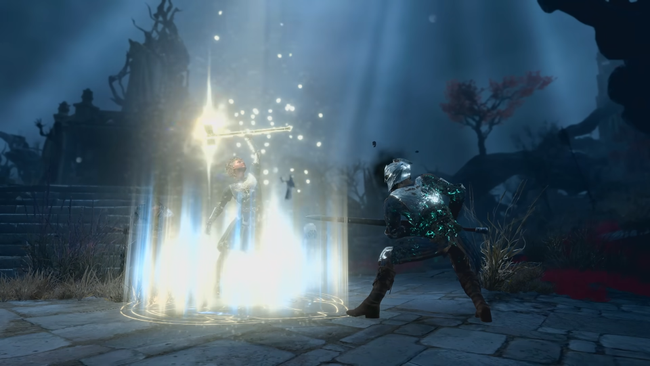
Multiclass Paladins
Paladins planning to multiclass should monitor their level progression to decide when and what to multiclass into, as many key Oath-based class features become available at different levels. Keep in mind that unless you're fine with becoming an Oathbreaker, even a multiclass character is subject to the tenets of their Paladin Oath, which could restrict your actions, depending on how you choose to roleplay.
With these points in mind, Paladins tend to be more popular as a two-level class to dip into for another main-class character.
A Paladin might split their overall levels with a Charisma-based caster like Sorcerer, Warlock or Bard to gain more effective uses of Divine Smite. Bards can gain weapon and gear proficiencies, Sorcerers can gain close combat proficiencies, and Paladins with levels of Warlock gain Eldritch Blast and some potent charisma-powered spell options.
Paladins with levels of Fighter can benefit from Action Surge and additional Fighting Styles.
Paladins with a Rogue level gain skill proficiencies, as well as mobility-enhancing actions. The addition of Sneak Attack will see little use, though, as Paladins just aren't built for stealth.
Barbarians can contribute to a Paladin's effectiveness, thanks to the Reckless Attack feature, as well as the fact that the Divine Smite action can be used when in Barbarian Rage.